|
Phase 3 - Design and Analysis of Interaction Metaphors for the Geographically Distributed Users
|
|
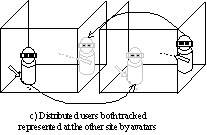
|
|
|
Overview
Summary
Distributed Interaction
Rubik's Cube Trials
Long-Term Trials
Miscellaneous
|
|
|
In the third phase we originally proposed to
study interaction techniques customised for the distributed situation.
Through early experiments it became obvious that the users could interact
very fluidly with each other. Thus we had two main objectives:
- Understanding cooperative user performance in IPTs compared to other
scenarios (Rubik's Cube Trials).
- Studying how users undertook cooperative tasks over extended periods
(Long-Term Trials)
|
|
|
This phase of the project saw significant
expansion due to Professor Schroeder's group having effort beyond that
anticipated in the proposal. Thus the experimental programme followed a
broader, but slightly different agenda. Previous to React/Interact, we had
collaborated with Schroeder's group on a series of experiments on assembly
of cube puzzles. Before React/Interact had started we had achieved an
experimental comparison of IPT-IPT interaction compared to IPT-desktop
interaction compared to undertaking the same task in the real world. This
experiment had shown that interaction between IPT could be very successful
and almost as good as task performance in the real world [18,
15]. These trials have been continued with input from UCL and support
from React/Interact [7].
The re-design of the interaction module DIVE 3.3x5 was in partly in
order to better support multi-user interaction between the two sites. The
result about successful collaboration between IPT-IPT would have been one
we would have looked for in React/Interact if it had not been achieved
already. To extend it, we undertook a series of longer-term trials with
Chalmers on long-term interaction between IPTs. This studied pairs of
users in the two IPTs over five 30 minutes sessions in one day. We were
looking for significant problems concerning the 3D interaction and
representation of users. Through a more ethnographic approach, the study
found many examples of successes and failures in interaction [20,6].
For example, we isolated examples of users pointing and gesturing at
objects they could not see and using the posture of their bodies to signal
intention. Specific instances such as these which simply aren't possible
with desktop display or even, in some cases, with HMDs suggest that IPTs
afford very natural interaction. |
|
|
In our previous research we have observed that
geographically distributed users often have very different reactions to
the environment and undertake shared tasks in very different ways. For
example, in a series of experiments we showed that immersion might convey
a leadership advantage. The experiments involved three users collaborating on a puzzle-solving
task that involved only locomotion about a small virtual environment. One
user wore a head-mounted display, the other two were using a desktop
system and in the series of experiments we used a variety of local and
wide area networking and two different VR systems (Division's dVISE and
DIVE). We were not able to establish what factor conveyed the
leadership advantage, but from observation of the users, it was apparent
that the immersed user was more easily able to understand and discuss the
arrangement of objects and users in the space.
A recent paper studies collaboration between an IPT system and a desktop. In this
experiment authors note that the IPT user is more often rated as the
heaviest contributor to the shared task. The subsequent hypothesis has to
be that the desktop user suffers from an impoverished user interface where
atomic interaction tasks take longer, thus leaving less time for
observation and perhaps conversation.
Part of the problem is that users can be confused by
how a user's actions map into interaction in the environment. Examples
include: user's misunderstanding what other users can see; user's not
correctly identifying gestures because it is difficult for them to infer
the appropriate direction in the environment; user's being confused being
action can take place at a distance with a virtual environment interaction
technique. Alleviating problems have been studied for collaborating
desktop users, but not for groups of users that includes one using a IPT.
|
|
|
We have continued the cube to cube trials [7].
|
|
|
The long-term trials involved pairs of users undertaking a
day of trials in two IPTs. The trials took 2.5 hours in total [20,6].
Some example images:
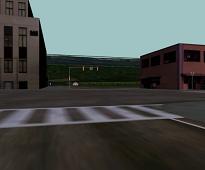
Village World
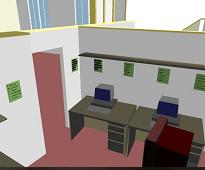
Poster World
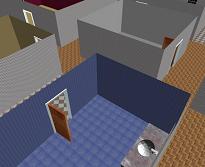
WhoDo World
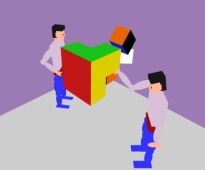
Puzzle World
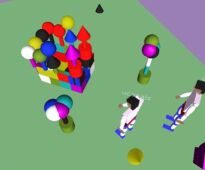
Modelling World
|
|
|
See the DIVE
page for example worlds used in these trials.
The VRJuggler/Interact software supports rudimentary client-server
operation. This was not developed sufficiently to use instead of DIVE for
the trials.
Run this Master config file first, the app will pause and wait for the
remote app to connect.
master.xml
The remote app must then run this Slave config file to connect to
master app (you may need to change the IP address contained in the config
file to point at the master node).
slave.xml
|
